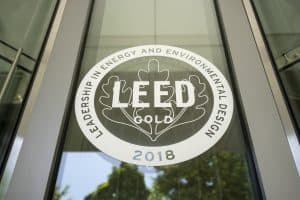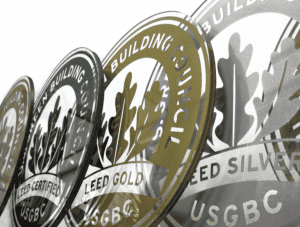LEED Spreads Throughout the World
 LEED (Leadership in Energy and Environmental Design) certified buildings save energy, save money in lower electric bills, and save on other resources. LEED-certified commercial and residential buildings give the occupants a healthier indoor environment. LEED buildings optimize energy efficiency and indoor water efficiency; often while using on-site sources of renewable energy.
LEED (Leadership in Energy and Environmental Design) certified buildings save energy, save money in lower electric bills, and save on other resources. LEED-certified commercial and residential buildings give the occupants a healthier indoor environment. LEED buildings optimize energy efficiency and indoor water efficiency; often while using on-site sources of renewable energy.
LEED has the most comprehensive energy efficiency standards among the currently operational major green building certification programs in the world today. LEED was launched in 1998 by the U.S Green Building Council (USGBC), and initially, LEED certifications were mainly given to buildings in the United States. However, during the previous decade, LEED began to designate certifications to buildings in many other countries, such as throughout Europe.
Many people worldwide want to optimize the construction of energy-efficient buildings, and new developments have taken root to make LEED programs widely available globally (LEED v4). This means that more people have access to LEED programs worldwide, and have the opportunity to reap the benefits of LEED for years to come.
"Leaders across the globe have made LEED the most widely used green building rating system in the world with 1.85 million square feet of construction space certifying every day. LEED certification provides independent verification of a building or neighborhood’s green features, allowing for the design, construction, operations and maintenance of resource-efficient, high-performing, healthy, cost-effective buildings. LEED is the triple bottom line in action, benefiting people, planet and profit." FROM>>> usgbc.org/resources/leed-brochure
Features of LEED
LEED homes and buildings are sustainable, provide people with a healthy indoor environment; and are modern, energy efficient buildings. Some of the basic features of a LEED building are:
- high indoor air quality - supporting the overall health of the building's occupants
- well-insulated, sealed air-tight buildings - for optimal savings on HVAC needs
- daylight & views - daylighting up to 75% of spaces - natural light provides some of the heat for the building; as well as supporting the overall well-being of the building's occupants
- construction waste management and use of renewable or recycled materials during construction
- energy efficient lighting, such as LEDs and CFLs
- optimize energy performance - often with on-site renewable energy sources such as geothermal heat pumps, rooftop solar panels, or PV arrays elsewhere on the property; or community solar. Building energy efficiency is also optimized; often with home energy management systems, programmable thermostats, and other smart appliances (including smart HVAC units). For other ways energy efficiency is optimized in buildings, please see - Improving Energy Efficiency
- water efficiency and stormwater management; insulated water heaters, or solar water heaters when suitable and requested
See - Improving Energy Efficiency - for a rundown of sustainable technologies currently used to optimize energy efficiency in buildings
Rating systems for LEED
 Each project that LEED certifies has different prerequisites and aspects to rate, and vary depending on the development site and type of building. LEED has a few different rating levels based on a point system (such as Silver, Gold, and Platinum) that are applied to each development designation for a LEED-certified building. The more efficiency and sustainability features a building has, the higher the points awarded. Here are a few construction and site development designations used in LEED ratings:
Each project that LEED certifies has different prerequisites and aspects to rate, and vary depending on the development site and type of building. LEED has a few different rating levels based on a point system (such as Silver, Gold, and Platinum) that are applied to each development designation for a LEED-certified building. The more efficiency and sustainability features a building has, the higher the points awarded. Here are a few construction and site development designations used in LEED ratings:
- “BD+C” means building design and construction. This deals with new constructions or major renovations that will dramatically change the existing structure.
- “ID+C” means interior design and construction, which deals with projects that make changes to a building's interior.
- The “O+M” designation deals with operations and maintenance, which only applies to buildings that already exist. There is only improvement work and little to no construction involved.
- The "ND" designation is for neighborhood development; new development projects or redevelopment projects containing residential uses, nonresidential uses, or a mix.
- "LEED Homes" - for single-family or multi-family homes, low to mid-rise buildings. Buildings greater than 6 stories use the BD+C designation.
"LEED Zero" has been added as an additional designation for a BD+C or O+M development that achieves net zero carbon, and/or net zero on water & waste.
LEED BD+C and ACPs
The LEED BD+C (building design & construction codes, for new building construction or major building renovation) were improved with the addition of a set of new construction codes as of 2014. In February of 2014, the United States Green Building Council (USGBC), in conjunction with the Sweden Green Building Council (SGBC), hosted members of the LEED International Roundtable, who came together to introduce a special, Europe-specific program for the LEED BD+C. This is called the Alternative Compliance Paths (ACPs).
SGBC has developed solutions that are specifically for Sweden in the past, and the Sweden Green Building Council brought ingenuity and advice to the ACPs program. A great example of a city using advanced, alternative construction practices to ensure the energy efficiency in new buildings can be found in Vaxjo, Sweden.
Here are a couple of succinct summaries of LEED certification principles:
“The five critical areas of focus, as laid out by the USGBC, are sustainable site development, water savings, energy efficiency, materials selection, and indoor environmental quality.
Sustainable site development involves, whenever possible, the reuse of existing buildings and the preservation of the surrounding environment. The incorporation of earth shelters, roof gardens, and extensive planting throughout and around buildings are encouraged.
Water is conserved by a variety of means including the cleaning and recycling of gray (previously used) water and the installation of building-by-building catchments for rainwater. Water usage and supplies are monitored.
Energy efficiency can be increased in a variety of ways, for example, by orienting buildings to take full advantage of seasonal changes in the sun’s position and by the use of diversified and regionally appropriate energy sources, which may—depending on geographic location—include solar, wind, geothermal, biomass, water, or natural gas.” FROM- britannica.com/technology/LEED-standards
[The other two LEED priorities, materials selection and indoor air quality, are covered extensively in Green City Times' green building overview article.]
WHY LEED?
"LEED is the most widely used green building rating system in the world. Available for virtually all building types, LEED provides a framework for healthy, highly efficient, and cost-saving green buildings. LEED certification is a globally recognized symbol of sustainability achievement and leadership.
Millions of people are living, working and learning in LEED-certified buildings around the world."
FROM - usgbc.org/leed/why-leed
Please see:
Please also see:
Vaxjo (passive house construction practices)